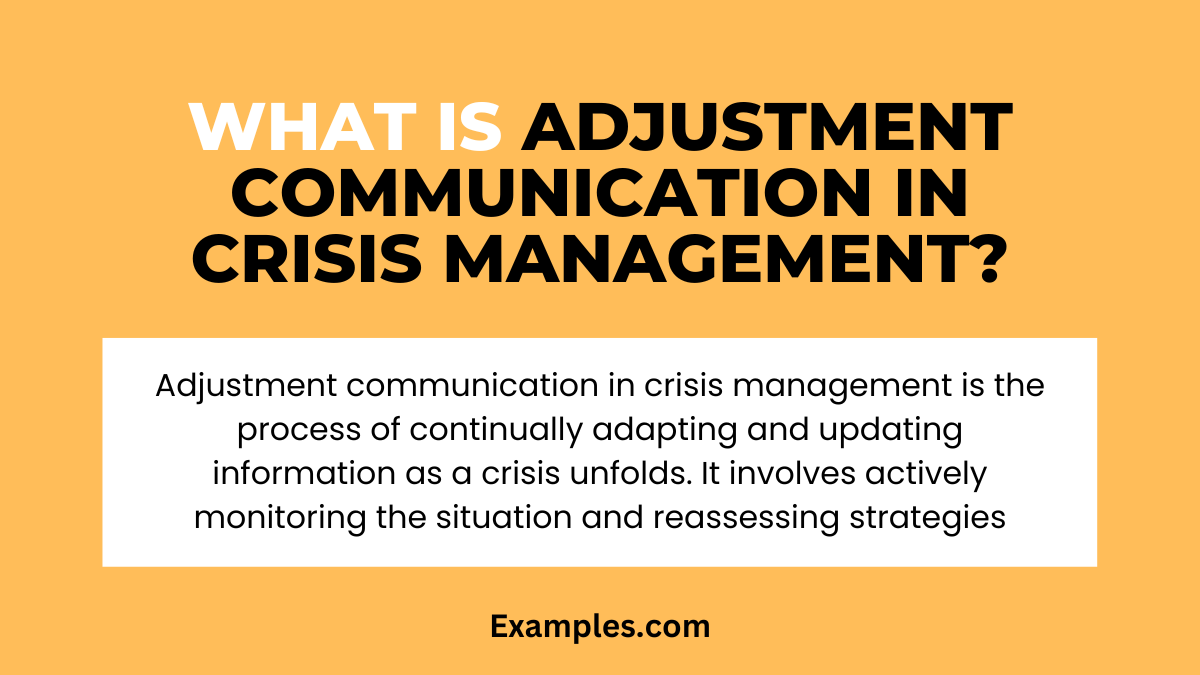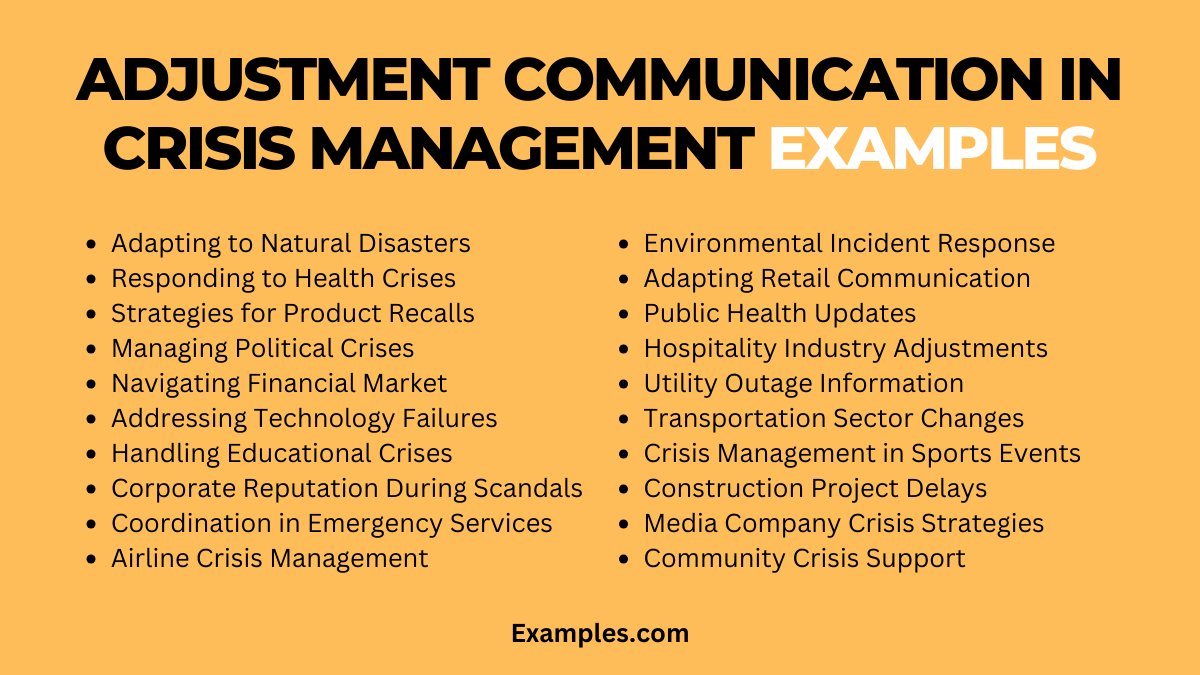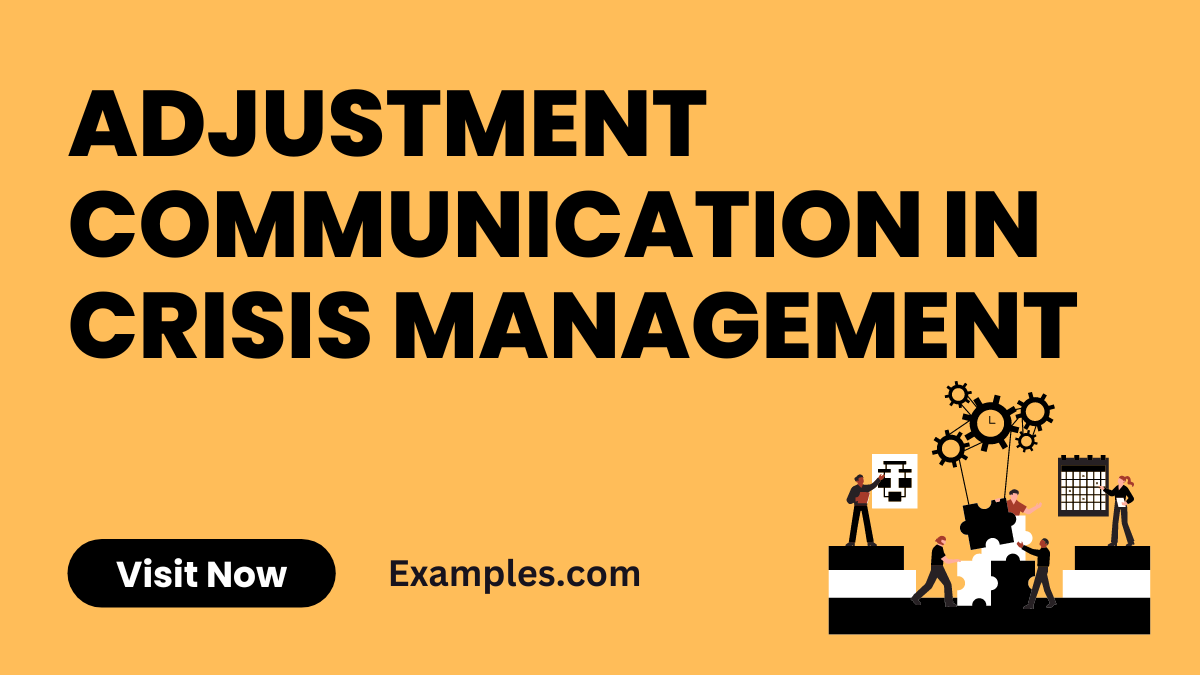19+ Adjustment Communication in Crisis Management Examples
Adjustment communication in crisis management is a vital process that focuses on adapting messages and strategies as a situation evolves. This comprehensive guide will explore various communication examples and techniques for effectively adjusting information in real-time during a crisis. Emphasizing flexibility and responsiveness, it covers how organizations can modify their communication approach to meet the changing needs of the situation and stakeholders. The guide also illustrates the importance of ongoing assessment and revision of communication strategies to effectively manage a crisis.
What is Adjustment Communication in Crisis Management?

Adjustment communication in crisis management is the process of continually adapting and updating information as a crisis unfolds. It involves actively monitoring the situation, reassessing strategies, and modifying messages to align with the latest developments and needs. This approach ensures that communication remains relevant, accurate, and effective throughout the crisis. It’s an essential component for maintaining trust and providing clarity to stakeholders during uncertain and evolving situations.
20 Adjustment Communication in Crisis Management Examples

Adjustment communication is a critical component in crisis management, focusing on adapting messages and strategies to evolving situations. It involves assessing the crisis’s impact and modifying communication to address stakeholders’ changing needs effectively. This approach helps organizations navigate crises with agility, ensuring timely and relevant responses.
- Adjusting to Natural Disasters: During a flood, a city council promptly updates evacuation routes and safety measures, emphasizing new challenges and solutions.
- Health Crisis Response: A hospital revises its visitor policies in response to a pandemic, clearly communicating the reasons and new procedures for patient safety.
- Product Recall Strategy: A company experiencing a product recall modifies its communication to address consumer concerns, providing updated information on refund procedures and safety measures.
- Political Crisis Management: A government body adjusts its communication during a political crisis, offering clear guidance and reassurance to the public.
- Financial Market Fluctuations: A financial institution changes its investor communication during a market crash, providing real-time updates and advice.
- Technology Failure Response: An IT company revises its communication during a major software outage, offering regular updates and workarounds.
- Educational Crisis Handling: A university alters its communication during a campus emergency, providing students and parents with updated safety instructions and support services.
- Corporate Reputation Management: A corporation adjusts its PR strategies in response to a scandal, focusing on transparency and remedial actions.
- Emergency Services Coordination: During a large-scale emergency, emergency services modify their communication to coordinate efforts and provide public guidance.
- Airline Crisis Response: An airline updates its communication following a flight delay, offering revised schedules and compensation details.
- Environmental Incident Management: In response to an oil spill, a company changes its communication to focus on environmental impact and cleanup efforts.
- Retail Crisis Adjustment: A retailer revises communication during a supply chain disruption, informing customers about product availability and alternative options.
- Public Health Updates: Health authorities update communication strategies during an epidemic to provide the latest health advice and restrictions.
- Hospitality Industry Changes: A hotel chain modifies communication during a tourism crisis, offering updated booking policies and safety protocols.
- Utility Outage Information: During a power outage, a utility company updates its communication with restoration times and safety precautions.
- Transportation Sector Adjustments: A transit authority revises communication during a transit strike, providing alternative travel advice.
- Sports Event Crisis Management: Organizers adjust communication for a sports event in response to unforeseen weather conditions, ensuring participant and spectator safety.
- Construction Project Delays: A construction company adjusts its communication strategy in response to project delays, keeping stakeholders informed of new timelines.
- Media Company Strategy Change: A media company adapts its crisis communication during a controversial news story, focusing on accuracy and balanced reporting.
- Community Crisis Support: In response to a community crisis, local authorities adapt their communication to offer support and resources to affected residents.
What is the Impact of Adjustment Communication in Crisis Management?
Adjustment communication significantly impacts crisis management by enhancing flexibility and responsiveness. It allows organizations to swiftly adapt their messaging as situations evolve, ensuring that information remains relevant and accurate. This approach minimizes misunderstandings and maintains stakeholder trust during crises. By being adaptable, organizations can better manage the dynamic nature of crises, reducing potential damage and facilitating a quicker resolution.
What are the Adjustment Communication Strategies in Crisis Management?
Here are the Adjustment Communication Strategies in Crisis Management:
- Regular Monitoring: Continuously monitor the crisis to update your communication strategy based on the latest developments. This involves staying informed about all aspects of the situation.
- Message Revision: Be flexible in updating and revising your messages. As new information becomes available, ensure your communication reflects these changes accurately.
- Tailored Communication: Customize your messages to resonate with different audiences. Consider the unique needs and concerns of each segment of your audience.
- Team Coordination: Keep the crisis communication team on the same page regarding any changes or updates in the messaging. Effective coordination ensures consistency and clarity.
- Transparency: Be open about changes in the situation or your strategy. Transparency builds trust and credibility, especially in times of crisis.
- Scalability: Adjust the scale and intensity of your communication efforts to match the severity of the crisis. As situations escalate or de-escalate, your communication should adapt accordingly.
- Evaluation: Regularly evaluate the impact and effectiveness of your communication adjustments. Continuous assessment helps in fine-tuning your strategy and approach.
How to Adjust Communication in Crisis Management?
Here are the points to remember while to Adjusting Communication in Crisis Management:
- Monitor Situation Closely: Regularly update your understanding of the crisis. This dynamic awareness allows for timely and relevant adjustments in communication.
- Flexibility in Strategy: Be prepared to change your communication strategy as the situation evolves. Flexibility ensures your messaging remains effective and appropriate.
- Stakeholder Feedback: Listen to how your audience is responding. Their feedback can provide valuable insights for refining your communication approach.
- Clear and Concise Updates: As the situation changes, provide updates that are both clear and to the point, avoiding unnecessary jargon or complexity.
- Empathy in Messaging: Recognize the emotional impact of the crisis on your audience. Tailor your messages to address their concerns and anxieties compassionately.
- Crisis Communication Team Coordination: Work in sync with your team to ensure a unified and effective communication approach. Regular meetings and clear roles help in maintaining coordination.
- Utilize Multiple Platforms: Use a range of communication channels to reach different audience segments effectively. This includes social media, press releases, and internal communication channels.
Tips for Effective Adjustment Communication in Crisis Management
Here are the Tips for Effective Adjustment Communication in Crisis Management:
- Rapid Responsiveness: Be agile in responding to new developments. Quick reaction is key in maintaining control and trust during a crisis.
- Message Consistency: While details may evolve, the core message should remain steady. This consistency helps in building credibility and clarity.
- Audience-Centric Approach: Customize communication to address the specific concerns and questions of different audience segments. Understanding your audience ensures that your message is relevant and effective.
- Transparent Communication: Be honest about what is known and openly acknowledge uncertainties. Transparency is crucial for building and maintaining trust.
- Calm and Reassuring Tone: Convey messages in a tone that soothes and reassures the audience. A calm demeanor can help to mitigate panic and anxiety.
- Scenario Planning: Prepare for different potential scenarios in advance. Having pre-planned responses ready can significantly improve reaction times.
- Regular Briefings: Provide ongoing updates to keep all stakeholders informed. Regular briefings ensure that everyone has the latest information.
- Avoid Overwhelming Information: Share essential information without overloading your audience. Too much information can lead to confusion and anxiety.
In conclusion, Adjustment Communication in crisis management is pivotal in addressing challenges and adapting strategies. This approach ensures that organizations can effectively navigate changes and uncertainties during crises. By prioritizing clear, adaptable communication, entities can maintain resilience, safeguard stakeholder interests, and emerge stronger post-crisis.



